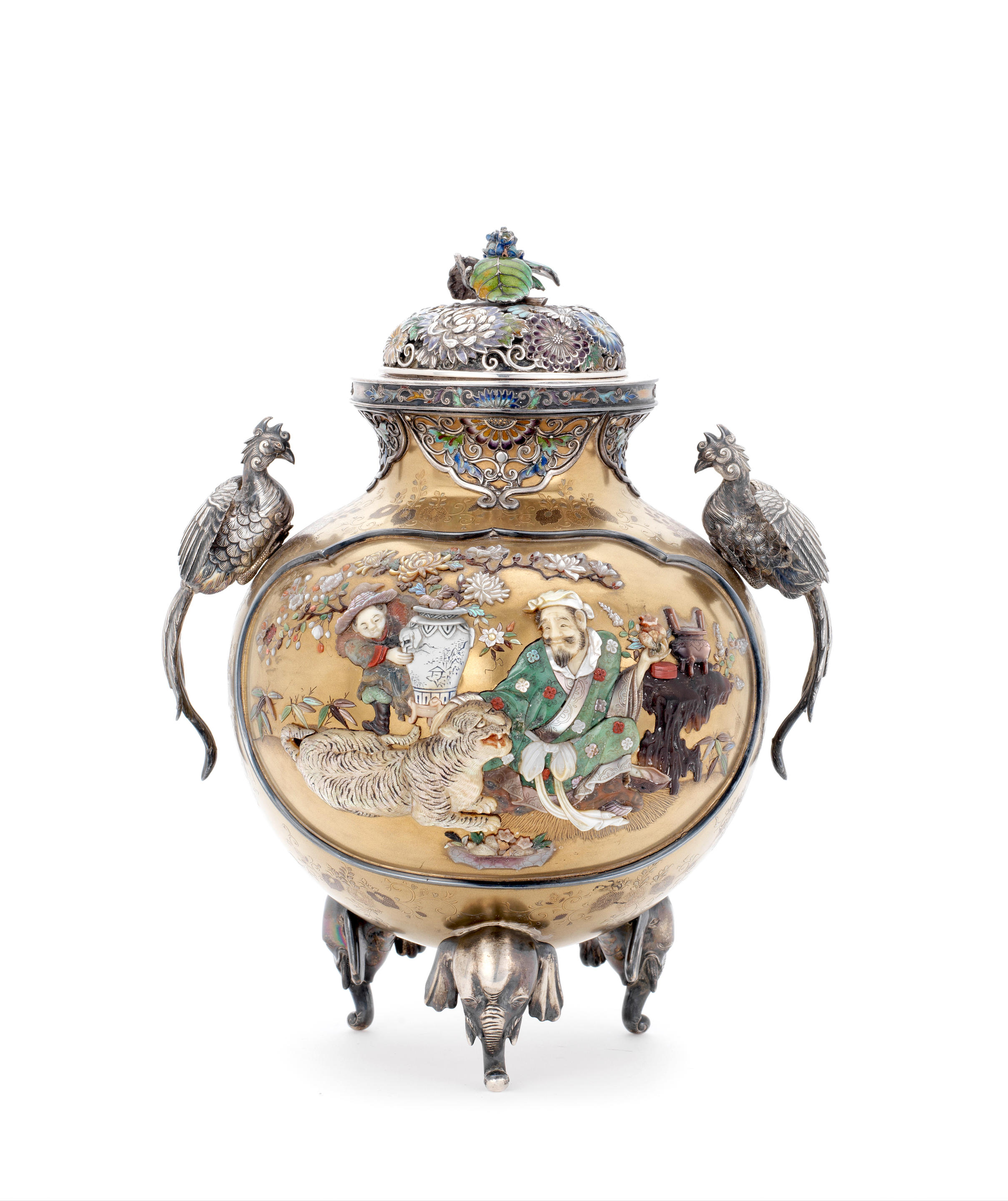A SMALL EMBELLISHED ‘POMEGRANATE’ CORAL SNUFF BOTTLE, 19TH CENTURY Katalognummer: CA0918-095 Coral with neatly incised inlays made from turquoise, amber and lapis lazuli. The bottle: China. The embellishment: Japan The bottle: 19th century, possibly even a bit earlier. The embellishment: late 19th – early 20th century. Of peach form with flat top and recessed foot surrounded by an oval foot rim, the embellishments carved in crisp relief with a pomegranate on a stem with two slender leaves growing from an ornamental rock. Coral is a symbol of longevity, due to its resemblance to a tree that seems to last forever. It was also a symbol of the first rank as civil officers of the first rank wore coral buttons on their hats. Coral was highly valued at Court and was considered to be the third most valuable gem. In the catalogue of the Exhibition of Ching Dynasty Costume Accessories, page 31, the order of value is given as pearl, ruby, coral, sapphire, lapis lazuli, quartz, shell etc. Coral was also the material used for the Emperor's Court necklace when worshipping at the Altar of the Sun, matched by a coral belt. Coral snuff bottles were produced for the Court throughout the early to mid-Qing period, and apart from the Palace workshops, we are told in Masterpieces of Snuff Bottles in the Palace Museum, page 29, that the records reveal that snuff bottles made of gems and gemstones (which included coral) were mostly produced at Imperial lapidary workshops in Suzhou and Yangzhou by order of the Emperor. The rarity of genuine early and mid-Qing coral snuff bottles is presumably due to the fact that only the occasional branch was large enough to make even a small snuff bottle. Several of the earliest known coral bottles were made in segments joined together, or when made from flawed material (which was all that was available), requiring either patches of coral inlaid to fill flaws, or wax inlays. Shape: Pear Hollowing: Good Mouth, neck and lip: Flat top with tiny mouth Base: Oval with raised foot rim Stopper: Green nephrite Height of the bottle with stopper: 4,6 cm. Width of the mouth: 4 mm. Width of the neck: 12 mm. Weight: 24,3 grams Condition: Excellent. Remainders of old glue near the inlays. Provenance: Hungarian private collection 小珊瑚巧雕”石榴花”鼻烟壺,19世紀 珊瑚壺身,上雕綠松石、琥珀及青金石 壺身:中國,19世紀或更早 雕飾:日本,19世紀晚期至20世紀初期 品相極好 匈牙利私人收藏 Schätzpreis 估價: € 400 Startpreis 起拍價: € 200
A SMALL EMBELLISHED ‘POMEGRANATE’ CORAL SNUFF BOTTLE, 19TH CENTURY Katalognummer: CA0918-095 Coral with neatly incised inlays made from turquoise, amber and lapis lazuli. The bottle: China. The embellishment: Japan The bottle: 19th century, possibly even a bit earlier. The embellishment: late 19th – early 20th century. Of peach form with flat top and recessed foot surrounded by an oval foot rim, the embellishments carved in crisp relief with a pomegranate on a stem with two slender leaves growing from an ornamental rock. Coral is a symbol of longevity, due to its resemblance to a tree that seems to last forever. It was also a symbol of the first rank as civil officers of the first rank wore coral buttons on their hats. Coral was highly valued at Court and was considered to be the third most valuable gem. In the catalogue of the Exhibition of Ching Dynasty Costume Accessories, page 31, the order of value is given as pearl, ruby, coral, sapphire, lapis lazuli, quartz, shell etc. Coral was also the material used for the Emperor's Court necklace when worshipping at the Altar of the Sun, matched by a coral belt. Coral snuff bottles were produced for the Court throughout the early to mid-Qing period, and apart from the Palace workshops, we are told in Masterpieces of Snuff Bottles in the Palace Museum, page 29, that the records reveal that snuff bottles made of gems and gemstones (which included coral) were mostly produced at Imperial lapidary workshops in Suzhou and Yangzhou by order of the Emperor. The rarity of genuine early and mid-Qing coral snuff bottles is presumably due to the fact that only the occasional branch was large enough to make even a small snuff bottle. Several of the earliest known coral bottles were made in segments joined together, or when made from flawed material (which was all that was available), requiring either patches of coral inlaid to fill flaws, or wax inlays. Shape: Pear Hollowing: Good Mouth, neck and lip: Flat top with tiny mouth Base: Oval with raised foot rim Stopper: Green nephrite Height of the bottle with stopper: 4,6 cm. Width of the mouth: 4 mm. Width of the neck: 12 mm. Weight: 24,3 grams Condition: Excellent. Remainders of old glue near the inlays. Provenance: Hungarian private collection 小珊瑚巧雕”石榴花”鼻烟壺,19世紀 珊瑚壺身,上雕綠松石、琥珀及青金石 壺身:中國,19世紀或更早 雕飾:日本,19世紀晚期至20世紀初期 品相極好 匈牙利私人收藏 Schätzpreis 估價: € 400 Startpreis 起拍價: € 200


.jpg)





Try LotSearch and its premium features for 7 days - without any costs!
Be notified automatically about new items in upcoming auctions.
Create an alert